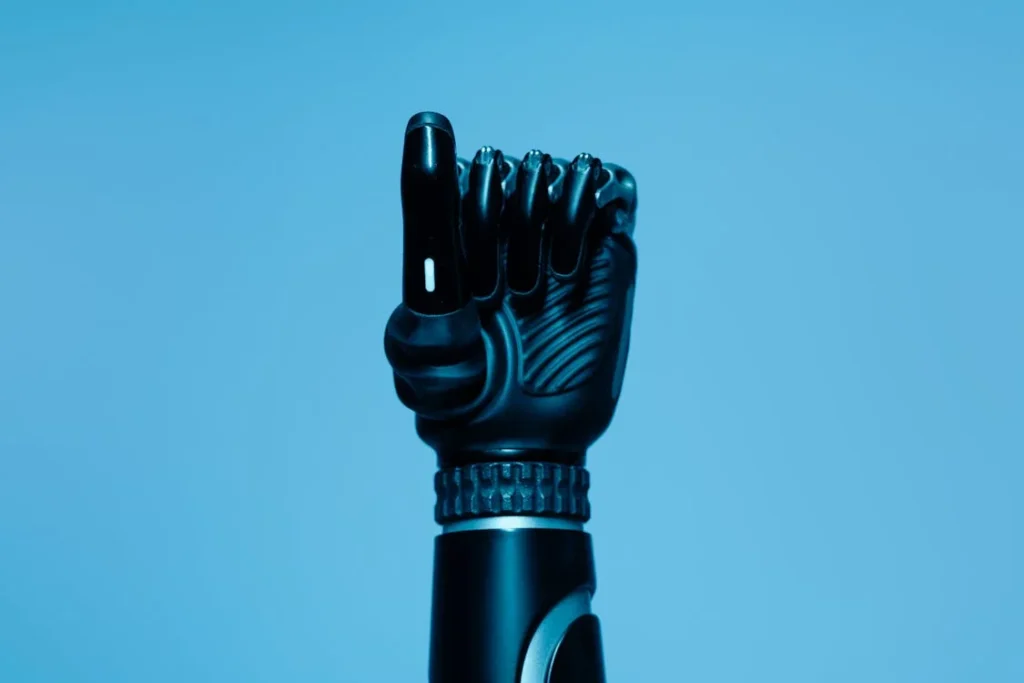Life after losing a hand can feel like starting all over again. Simple things—like opening a water bottle, holding a pen, or typing on a keyboard—suddenly become hard. Tasks that once took seconds now feel like mountains. It’s frustrating, tiring, and can take a toll on your confidence.
But what if you had a hand that could help you do those things again? A hand that listens to your muscles and moves just like you want it to. That’s what the Grippy™ Bionic Hand does. It’s not just a piece of tech. It’s a second chance. A way to live fully again, without asking for help every time you need to write a note or open a snack.
At RoboBionics, we’ve met hundreds of people who’ve felt stuck—people who wanted more from life but didn’t have the right tools. That’s why we created Grippy. It’s light, affordable, and made right here in India. And most importantly—it works.
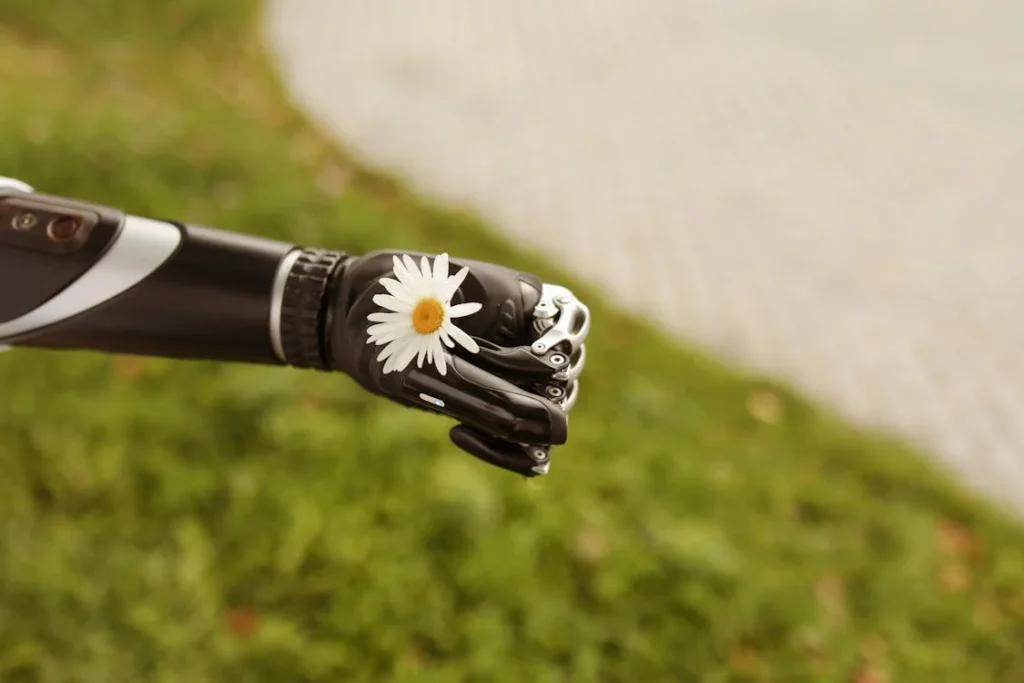
Opening Bottles with Grippy™: Regaining Control, One Twist at a Time
Why Opening a Bottle Is More Than Just a Task
When most people think about opening a bottle, they don’t give it much thought. It’s just something your hand does automatically—grip, twist, and done. But for someone with a below-elbow amputation, this simple action can feel like a battle.
The reason is clear: opening a bottle needs a strong, steady grip and the right amount of rotation. Without a natural hand, the coordination and force needed for this task are hard to achieve.
This is where Grippy™ steps in—not just as a replacement, but as a reliable partner that understands your intent. It reads your muscle signals, figures out what you’re trying to do, and helps you do it.
The goal isn’t just function—it’s freedom. The freedom to grab a water bottle after a long walk, open a juice bottle while watching TV, or twist the cap off your favorite cold drink without thinking twice.
For someone wearing a Grippy™ for the first time, that first successful twist can bring tears. It’s not about the bottle—it’s about the moment. It’s about not needing to ask your child, friend, or parent for help. It’s about reclaiming your space in the kitchen, in your office, or during travel. That’s real independence.
How Grippy™ Makes Bottle Opening Easy
Grippy™ is smart, but it’s also incredibly practical. The secret lies in how it mimics the natural movements of a human hand. When you try to grip something, your brain sends signals to the muscles in your forearm. Grippy™ picks up these signals using sensors on the skin.
When it senses the right kind of signal—like when you’re trying to pinch or grip—it activates the motor inside and tightens the fingers, just like a natural hand would.
To open a bottle, you simply place the Grippy™ hand around the cap. The hand adjusts its grip automatically. It’s firm but not too tight. You then use your other hand or even just your body to hold the bottle steady.
With a gentle twist of the wrist, Grippy™ turns the cap and loosens it. That’s it. The first time it happens, people often look surprised—like they just did a magic trick. But it’s not magic. It’s technology that listens to you.
The hand’s Sense of Touch™ technology plays a big role here too. This feature gives you feedback when you’re holding something. You can actually feel the pressure—whether it’s too loose or just right.
That means you’re not guessing anymore. You’re in control. The hand isn’t just doing what it wants; it’s doing what you want, how you want.
What’s even more helpful is how lightweight the Grippy™ hand is. Many imported prosthetics are heavy, and using them for something like opening a tight cap can feel like lifting weights.
But with Grippy™, the weight is evenly distributed. That means you can use it comfortably for long stretches, even if you have a lot of things to open—like bottles, jars, or tubes.
Real Stories from Real People
Let’s talk about Ramesh, a 28-year-old who lost his hand in a factory accident. He told us that before getting Grippy™, he had stopped drinking bottled juice altogether.
“I would wait for someone to come home,” he said, “because I couldn’t twist the cap open myself.” It may sound small, but over time, those small moments added up. They made him feel dependent, even helpless.
After getting his Grippy™ hand fitted, things changed. “The first time I opened a bottle without help, I felt like a kid again,” he laughed. “It sounds silly, but I actually celebrated with a second bottle!”
That joy—the simple happiness of doing something by yourself—was written all over his face. It’s a feeling we’ve seen again and again with Grippy™ users.
Then there’s Aarti, a college student in Pune. She uses Grippy™ every day to open her water bottle between classes. “Nobody stares anymore,” she said. “It feels natural. My friends even forget I’m using a bionic hand.” That’s the power of great design—it blends into life.
Training the Hand, Trusting Yourself
Of course, there’s a learning curve. Most users don’t master bottle opening on day one. But with a little practice, muscle memory builds.
We provide one-on-one support during and after fitting to help you learn how to grip correctly, apply the right pressure, and get used to the hand’s feedback system. Think of it like learning to ride a bicycle. At first, you’re unsure. But soon, your body remembers.
Our in-house team also guides users on choosing the right hand mode. Grippy™ has different grip types built in. Some grips are better for power, others for precision.
When opening bottles, the power grip is often the most effective. We help you select and switch between modes easily, so you always have the right tool for the job.
The best part? Grippy™ adapts with you. As you get stronger and more confident, the hand keeps up. It doesn’t hold you back. In fact, many users tell us that after a while, they stop thinking about the hand entirely. It becomes a part of them.
More Than Just a Hand
Yes, Grippy™ helps you open bottles. But it also gives you back something more valuable—confidence. When you can do things on your own, without asking or waiting, you feel more like yourself again. And that feeling is priceless.
Whether you’re getting a drink after a workout or pouring water for guests at home, the ability to open bottles is part of daily life. It shouldn’t be a challenge. With Grippy™, it isn’t.
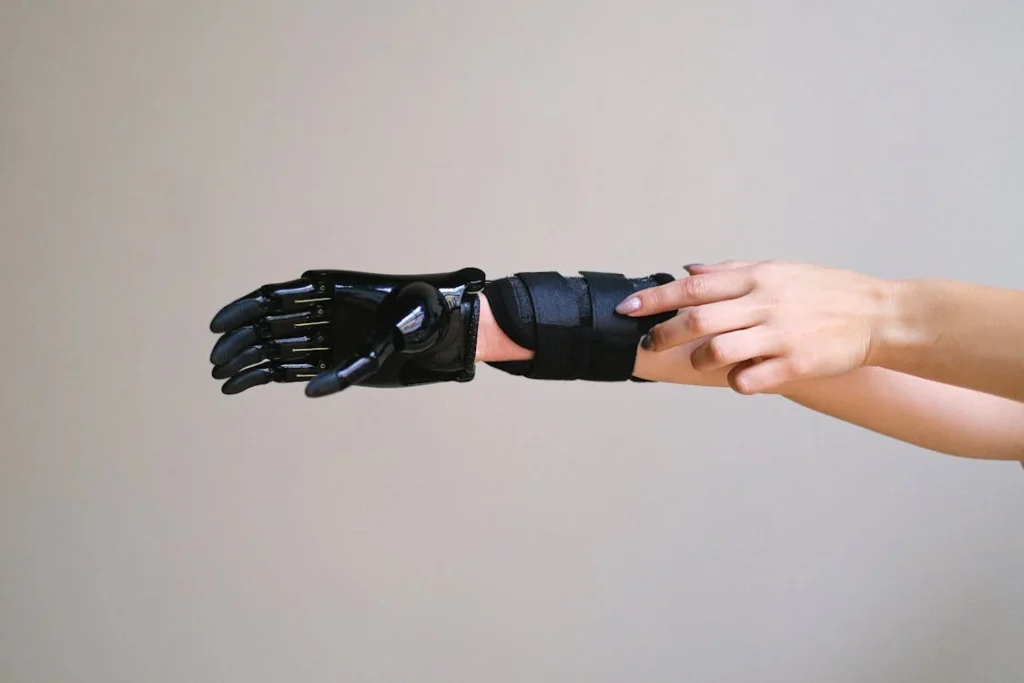
Writing with a Grippy™ Hand: Bringing Words Back to Life
Holding a Pen, Holding on to Hope
Writing is more than just putting words on paper. It’s how we express ourselves. It’s how we sign our names, fill out forms, leave notes for loved ones, and even sketch ideas.
Losing the ability to write can feel like losing your voice. It creates distance—between you and your thoughts, your work, your memories.
For someone who’s lost a hand, holding a pen again can be a deeply emotional experience. That’s why at RoboBionics, we designed Grippy™ not just to perform tasks, but to reconnect people with the things they love.
Writing was high on that list. We knew it couldn’t be clumsy or mechanical. It had to feel natural, fluid, and real. Because when you hold a pen, you’re not just gripping plastic—you’re reclaiming your story.
The Feel of the Grip, the Flow of the Ink
Writing with a Grippy™ hand starts with choosing the right grip. The hand is built with multiple grip types that you can switch between. For holding a pen, the “precision grip” works best.
It allows the fingers to come together and pinch objects gently but firmly. This grip is ideal for slim items like pens, pencils, or paintbrushes.
When you want to write, you simply position the pen between the fingers of the Grippy™ and activate the grip using your forearm muscles. The sensors on your skin read the signal and tell the fingers to close.
The pressure is balanced—firm enough to hold the pen without dropping it, but light enough to avoid snapping it or crushing it. It’s a careful dance, and Grippy™ gets it just right.
The wrist movement adds another layer of control. With a small twist or bend, you can position the pen at a natural angle. This makes writing smoother and less tiring. Once the grip and angle are in place, all that’s left is to move your arm and write.
And here’s the beautiful part: the Sense of Touch™ technology helps you know how firmly you’re holding the pen. If the grip is too loose, you’ll feel it. If it’s just right, you’ll feel that too. That feedback helps you stay in control, without second-guessing yourself.
From First Lines to Full Pages
For first-time users, writing with a bionic hand might feel slow. You may start with short strokes, small letters, or just scribbles. But each stroke is a step forward.
Over time, your control improves. The letters get clearer. Your confidence grows. And suddenly, you’re filling out forms again, making grocery lists, or jotting down phone numbers.
One of our users, Anil, a retired teacher from Nashik, told us something we’ll never forget. After his accident, he stopped writing in his diary. “I felt like I lost my voice,” he said. “But the day I wrote again with Grippy™, it was like coming back to life. I wrote one full page, and then I cried.”
Another user, a teenager named Ravi, used Grippy™ to complete his school exams. “I thought I’d have to dictate everything to someone else,” he said.
“But with practice, I could write fast enough to finish on time. My teachers were amazed.” Today, Ravi dreams of becoming a writer. And he’s already on his way.
What’s incredible is how quickly the muscle memory kicks in. Once your body starts to trust the hand, the movements become natural. Writing no longer feels like a chore. It feels like an extension of you. You stop thinking about the steps. You just write.
Custom Tips and Personalized Training
At RoboBionics, we know that every hand is different. That’s why we offer custom training for each user. Some people prefer thicker pens. Others need more finger support.
We help adjust the grip settings, suggest pen types, and even modify the hand’s sensitivity to suit your comfort.
In some cases, we use special rubber tips or pen holders that make writing easier. These tools aren’t about making things simpler—they’re about making things possible.
We also provide digital practice sheets and exercises to help you get used to writing with Grippy™. It’s not just about physical skill—it’s about rebuilding trust in yourself.
For children, we often add fun writing games and encourage them to draw and color. This makes the process exciting rather than frustrating. When they start drawing stars or writing their names, their faces light up. And for parents, it’s a moment of pure joy.
Writing the Next Chapter, Literally
Grippy™ doesn’t just give you a hand. It gives you your handwriting back. It gives you your voice back. From signing documents to writing love notes, every mark you make is yours again. And each time you write, you’re telling the world: “I’m here. I’m strong. And I’m writing my own story.”
So whether it’s a signature on a job application, a birthday message, or a page in your journal, Grippy™ helps you make it happen. It’s not just a tool. It’s your hand, your expression, your identity.
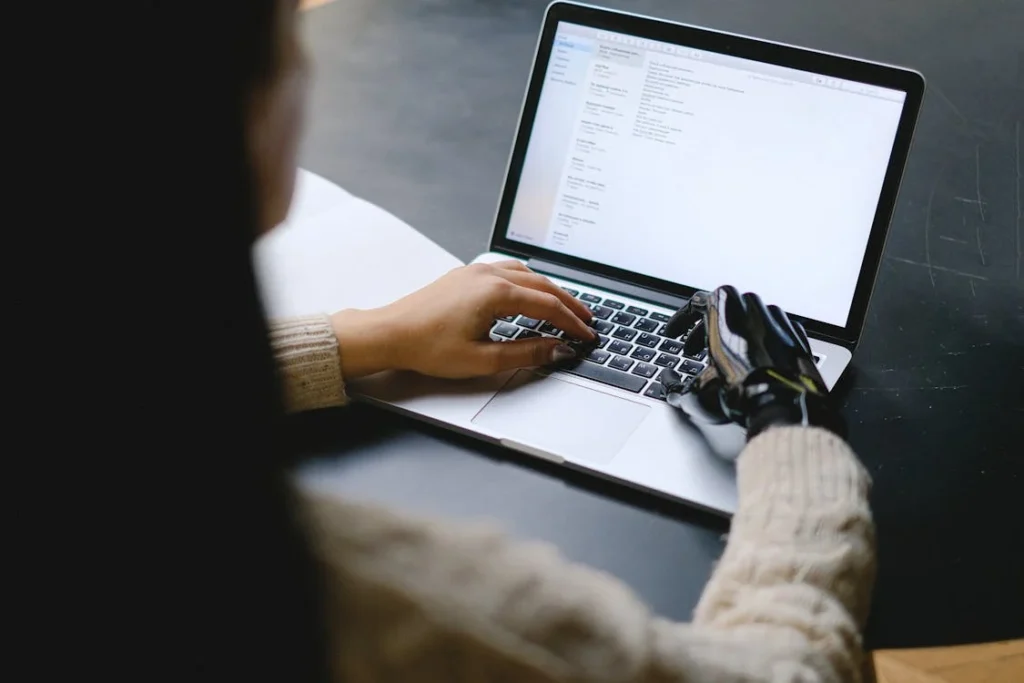
Typing with a Grippy™ Hand: Getting Back to Work and Play
Why Typing Matters More Than Ever
In today’s world, typing isn’t optional—it’s how we study, work, connect, and express ourselves. From sending emails to chatting with friends, from writing school projects to browsing online, typing has become part of everyday life.
For people who’ve lost a hand, that sudden break in routine can be overwhelming. The laptop that once felt like a tool now feels like a wall. Every missed keystroke feels like a reminder of what was lost.
We understand how frustrating that is. That’s why Grippy™ is designed to bring typing back into your life—not as a challenge, but as a joy. It’s not just about pressing keys; it’s about feeling productive again. It’s about sending your first message after an accident.
It’s about applying for a job online, writing to a loved one, or simply searching for your favorite song. That’s why typing with Grippy™ means so much more than just using a computer—it means rejoining the world.
The Science Behind Typing with Grippy™
Let’s break down how Grippy™ makes typing smooth and natural. Typing requires quick, precise finger movement, but it doesn’t always need a tight grip. That’s where the Grippy™’s fine motor control shines.
The hand uses sensors to detect tiny movements in your forearm muscles. These are the same signals your brain sends when you think about tapping or pointing.
Once Grippy™ picks up that signal, it translates it into a light touch or tap. The fingers of the hand respond quickly and accurately. You can adjust the pressure to avoid hitting keys too hard.
This helps you type comfortably without pressing two keys at once or having to constantly correct mistakes.
The wrist and arm movement also play an important role. When typing with Grippy™, you move your whole arm slightly to reach the desired keys. Think of it like using your index finger to type, but with way more control.
Over time, this movement becomes second nature. You don’t have to look down at the keyboard anymore. Your hands remember where to go.
The Sense of Touch™ feature helps here too. It gives gentle feedback as you type, so you know if the key was pressed successfully. That way, you don’t need to keep checking the screen. It builds confidence, speed, and rhythm.
What Typing Looks Like in Real Life
Meet Priya, a graphic designer from Chennai. After an accident left her without a hand, she worried her career was over. “My job is 100% on the computer,” she told us. “If I can’t type, I can’t work.” When she got fitted with Grippy™, she was surprised at how natural typing felt.
“At first, I was slow. I could only type with my left hand. But once I trained with Grippy™, I could type with both hands again. Now, I’m back to full speed—and no one can even tell.”
Then there’s Deepak, a college student studying computer science. For him, coding is everything. After losing his right hand, he feared he’d have to change fields. “I thought, who’s going to hire a coder who can’t type?” But after using Grippy™, his confidence shot up. “I can type long lines of code now. It’s not just about school—it’s about my dream.”
These aren’t just stories. They’re proof. Proof that when technology meets the right design, lives change.
Training to Type Again
Typing with a bionic hand takes practice. We help every Grippy™ user with personalized training that starts slow and builds gradually. First, we work on finger placement. Then we practice short words. Soon, users can write full sentences, then paragraphs, then entire documents.
We also provide software tools that highlight typing accuracy and speed. These tools are fun to use and help build confidence. Users often feel excited to track their progress—and even compete with themselves to type faster.
For children and young adults, we make typing feel like a game. This keeps frustration low and motivation high. In schools, we’ve even worked with teachers to create adapted learning environments where students using Grippy™ feel fully included.
And for professionals returning to work, we help set up ergonomic workstations. The goal is to keep the body relaxed and prevent strain. A comfortable desk, the right chair height, and correct keyboard placement can make a big difference.
Typing Freely, Living Fully
Once you can type again, the world opens up. You can write resumes, chat with friends, email doctors, attend online classes, and even build websites. The sense of independence is unmatched. You’re not waiting on someone to help anymore. You’re back in control.
It’s about feeling capable again. Typing may seem small, but the freedom it gives is massive. With Grippy™, that freedom is no longer a dream. It’s a reality.
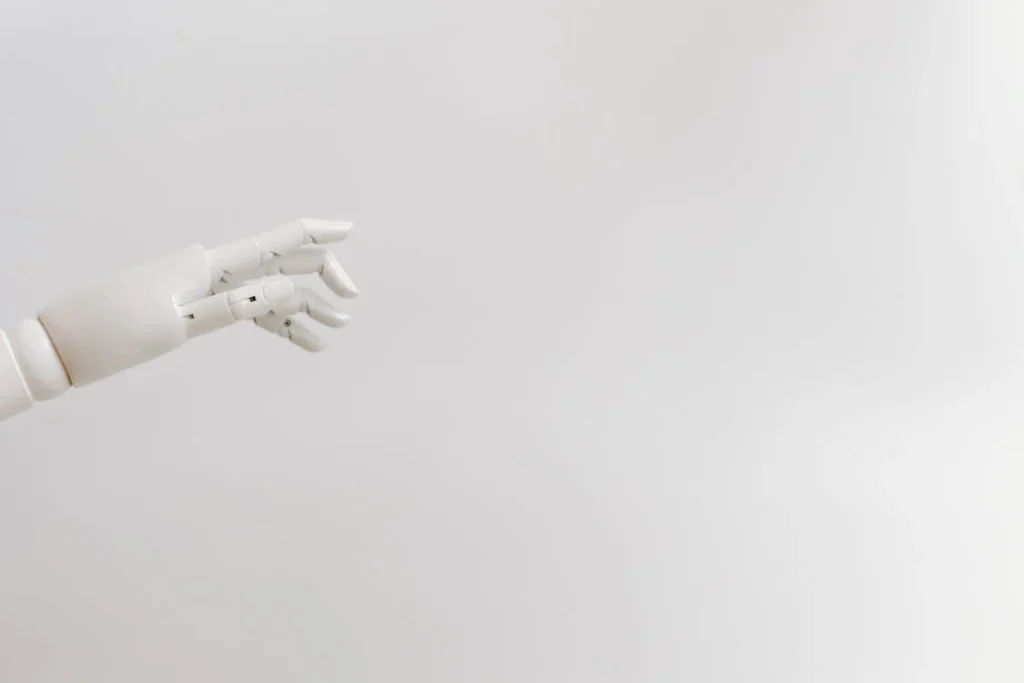
Cooking with Grippy™: Bringing Back the Joy of the Kitchen
The Heart of the Home, Restored
For many people, the kitchen is more than just a place to cook. It’s where families gather, where stories are shared over tea, and where the smell of fresh food brings back warm memories.
But after losing a hand, this special place can start to feel distant. Cooking becomes difficult, even dangerous. Chopping, stirring, lifting, and opening packets—all of it can feel impossible.
At RoboBionics, we’ve met people who used to love cooking but gave it up after their accident. Not because they stopped caring, but because they felt helpless. That’s where Grippy™ changes the story.
It gives users the ability to return to the kitchen not as a visitor, but as the one in charge. It’s not just about making meals—it’s about reclaiming routine, dignity, and joy.
Handling Kitchen Tools with Confidence
Cooking involves a mix of strength, precision, and control. Whether it’s holding a spoon, peeling vegetables, or pouring water, your hands need to do different things quickly and smoothly. Grippy™ is designed to adapt to those needs.
With multiple grip modes and responsive myoelectric sensors, it allows users to switch between tasks effortlessly.
Let’s say you’re stirring a pot. Grippy™ lets you hold the spoon firmly and make circular motions with ease. The hand responds to the signals from your muscles, maintaining just the right pressure.
Want to chop vegetables? Grippy™ can hold the produce steady while your natural hand works the knife. You don’t need to worry about slipping or losing grip—the hand stays steady thanks to the intelligent grip system.
For many users, this feels like getting their rhythm back. They can cut, stir, hold, and serve. They can switch between spatulas and ladles without fumbling. And because the hand is lightweight, it doesn’t tire you out even during longer cooking sessions.
Overcoming Small Challenges with Smart Design
One of the most common challenges in the kitchen is dealing with food packets, jars, and containers. With Grippy™, these aren’t problems anymore. Its precise grip allows users to open spice jars, cut open sachets, and lift utensils.
The Sense of Touch™ feature provides just enough feedback to know when you’re gripping a bag or container tightly enough—not too little, not too much.
We’ve even seen users flip rotis with tongs held by Grippy™, or pour chai using a kettle. These may sound like small things, but they mean the world to someone who thought those tasks were behind them forever.
The fingers of Grippy™ are shaped to hold curved, flat, or uneven surfaces. Whether it’s a cup, a knife handle, or a mixing bowl, the hand molds its grip to match. That flexibility is what gives users the confidence to try new tasks every day.
Real-Life Kitchens, Real Transformations
Meet Shobha, a homemaker from Nagpur. She used to cook three meals a day for her family before losing her hand in a road accident.
For months, she avoided the kitchen. “I didn’t want my children to see me struggle,” she said. But after getting her Grippy™ hand, things changed. “The first time I made chapati again, my husband clapped. It was a small thing—but it brought back our old life.”
Then there’s Ajay, a young bachelor living on his own in Hyderabad. “I couldn’t keep ordering food forever,” he said. “So I had to find a way to cook again.”
With Grippy™, he now makes dal, rice, and even his favorite omelet. “It’s not just about saving money,” he laughed. “It’s about being able to live on my own terms.”
These are not staged stories. These are daily moments of triumph. When users cook their favorite meals again, it’s not just their taste buds that come alive—it’s their spirit.
Safety First, Always
We know kitchens can be risky, especially when dealing with hot surfaces or sharp tools. That’s why Grippy™ is built with safety in mind. The materials are heat-resistant up to a certain range, and the grip strength can be adjusted to avoid accidents.
We always advise users to start slow, avoid open flames initially, and focus on safe, repetitive movements.
In fact, many users start with simple tasks like making sandwiches or preparing tea before moving on to full meals. With time and support, they regain not just skill—but trust in themselves.
Cooking Up Confidence, One Meal at a Time
Cooking isn’t just about food. It’s about creating something, caring for others, and feeling useful. With Grippy™, users rediscover all those things. The clink of utensils, the sizzle of oil, the smell of fresh coriander—all of it comes back. And in those small, beautiful moments, they feel whole again.
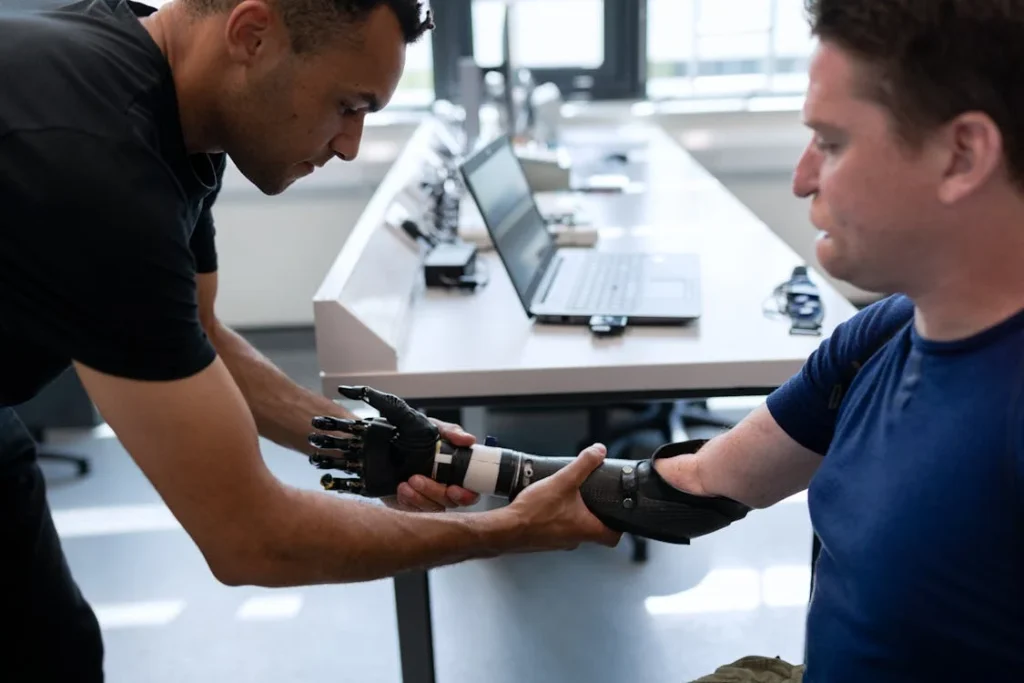
Parenting with Grippy™: Rebuilding Bonds, One Gentle Touch at a Time
The Invisible Weight of Not Being Able to Care
One of the most painful things about losing a hand isn’t the physical loss—it’s the emotional distance that often follows. For parents and caregivers, especially, the loss can feel overwhelming.
Simple acts like buttoning a child’s shirt, tying shoelaces, or even picking up a crying toddler become difficult. The heart aches not just from the task you can’t do, but from the closeness you feel slipping away.
We’ve seen that pain firsthand. We’ve sat with parents who told us how they stopped playing with their children or avoided feeding them because they felt inadequate. It’s not about pride—it’s about love.
When you can’t care for someone the way you used to, it breaks your heart. That’s why we made sure Grippy™ wasn’t just strong and functional, but gentle and intuitive too. Because parenting isn’t just about doing—it’s about being present.
The Gentle Power of Touch
With Grippy™, holding your child’s hand becomes possible again. The bionic hand adjusts to soft objects and responds with care. You can grip a soft toy, stroke your baby’s back, or brush their hair gently.
That’s where our Sense of Touch™ technology becomes a game changer. It gives you just enough feedback to feel what you’re holding. You know if you’re gripping too tight or too soft—just like with a natural hand.
Many parents we work with tell us that they were afraid of using any prosthetic around their kids. “What if I hurt them?” they ask. That fear is real—and valid. But Grippy™ is different.
Its precision grip and adjustable pressure give parents the control they need to feel safe and confident. They can hold a baby bottle, change a diaper, or even zip up a jacket. With practice, the movements become second nature, and the fear fades.
Getting Back into Daily Routines
Imagine helping your child get ready for school again—packing their lunchbox, tying their shoes, adjusting their collar. These aren’t big tasks, but they hold so much meaning.
They say, “I’m here. I’m still your parent.” Grippy™ gives you that ability back. The power grip mode helps you hold objects like lunch containers or water bottles. The precision grip lets you manage smaller tasks like handling hair ties or school supplies.
One user, Kavita, told us how she stopped helping her daughter get ready for school after her accident. “My husband had to do it all. I felt like I was missing out.”
But with Grippy™, she found her way back. “Now my daughter waits for me to help. She even tells me, ‘Mummy, your robot hand is cool!’” That moment of shared joy—of reconnecting with her role—is what drives our mission.
Another user, Sameer, uses Grippy™ to bottle-feed his newborn son. “At first I thought I’d never be able to hold the bottle steady,” he said. “But now, I do night feeds while my wife sleeps.
It’s my bonding time.” These moments are quiet but powerful. They rebuild relationships in ways no machine ever could—unless that machine is built with the heart in mind.
Playing, Cuddling, and Connecting Again
Parenting isn’t all tasks. It’s play, laughter, hugs, and high-fives. It’s being able to toss a soft ball in the park or hold your child close during story time. Grippy™ brings these moments back.
The fingers are shaped to safely hold soft toys or balls. The wrist movement helps with playful gestures, like pretending to tickle or clap.
We’ve even seen parents use Grippy™ to read bedtime stories, turning pages smoothly with one hand while cuddling their child with the other. That’s the kind of care and warmth that goes beyond technology. It’s about presence. And Grippy™ makes that presence possible again.
Caregiving for Elders and Loved Ones
The same benefits extend to caregiving. Many of our users are responsible not just for children, but for aging parents or disabled siblings.
Tasks like preparing medicine, adjusting pillows, combing hair, or helping with clothes are deeply intimate. They require trust, patience, and a gentle hand.
Grippy™ supports these tasks with steady grip and quiet control. It allows caregivers to do their jobs with grace and dignity. It lets them care not out of obligation—but out of love.
We remember Amarjeet, who takes care of his mother at home. “Before Grippy™, I couldn’t help her comb her hair. She would cry, and I would cry.” Now, he helps her every day. “She says my bionic hand is better than my real one,” he laughs. “It never gets tired.”
Healing the Invisible Wounds
The pain of not being able to care for your loved ones is deep. It often goes unseen. But when you get that ability back—even in small doses—it starts to heal the invisible wounds. Grippy™ doesn’t just help with tasks. It restores roles. It gives you back your identity as a parent, partner, child, or caregiver.
And in doing so, it brings you closer to the people who matter most.

Conclusion
Grippy™ isn’t just a tool. It’s a second chance at the life you love. Whether it’s opening a bottle, typing an email, helping your child get ready for school, or stirring a pot of dal, these everyday moments matter. They build confidence. They restore dignity. And they remind you—and everyone around you—that your story isn’t over.
At RoboBionics, we don’t just build prosthetic hands. We help people stand tall again. With every movement Grippy™ makes, there’s a heartbeat behind it. A heartbeat of care, courage, and quiet determination.
You deserve to live fully. To do more than just get by. If you or someone you love is ready to take that next step, we’re here to walk beside you.
Book a free demo now and see how Grippy™ can change your life—one small, powerful moment at a time.



